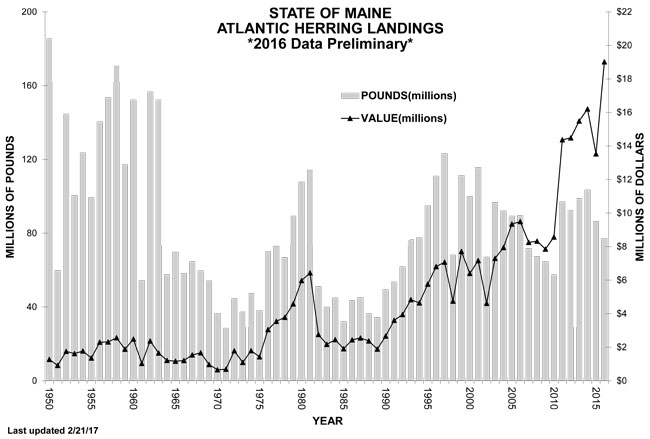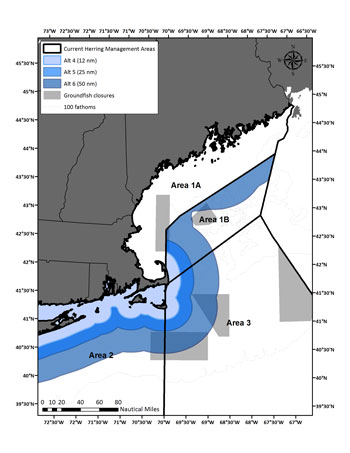Herring Depletion and User Conflict Amendment Goes to Public Comment
by Laurie Schreiber
“This is three years deep.
We’ve been in this
no man’s land
for a couple of years.”
– Chris Weiner,
American Bluefin Tuna
Association and the
CHOIR Coalition
NEWPORT, R.I.—Given the wide range of opinions expressed by many stakeholders about the role of Atlantic sea herring in the ecosystem, as well as localized depletion and user conflicts, the New England Fishery Management Council (NEFMC) voted at its Dec. 5 meeting to send draft Amendment 8 to his herring management plan out for public hearing without selecting a preferred alternative.
The range of measures under consideration in Amendment 8, to address potential localized depletion and user conflicts, includes: area closures; gear prohibition areas; modification to management area boundaries; and seasonal restrictions.
One of two major components in the amendment deal with potential localized depletion and conflicts. NEFMC approved a list of alternatives that includes nine primary alternatives and several spatial and seasonal sub-options designed to address the issues while minimizing biological and socioeconomic impacts.
• Alternative 1 – “no action.”
• Alternative 2 – A closure to all vessels and gear types fishing for herring within 6 nautical miles from shore in Area 1A with a two-year sunset clause and two seasonal sub-options.
• Alternative 3 – A year-round prohibition on using midwater trawl gear in herring management Area 1A.
• Alternatives 4, 5, and 6 – Three “buffer zone” proposals that would prohibit midwater trawl gear inside of 12 nm, 25 nm, and 50 nm respectively with a variety of spatial and seasonal sub-options.
• Alternative 7 – A prohibition on midwater trawl gear within five different thirty-minute squares, with various spatial and seasonal sub-options.
• Alternative 8 – Revert to the original boundary line between Area 1B and 3, but maintain the current Area 2/3 boundary.
• Alternative 9 – Remove the seasonal closure in Area 1B so that the area opens on Jan. 1 instead of May 1.
At NEFMC’s Dec. 5 meeting, commenters mainly supported sending the amendment out for public hearing without a preferred alternative.
“This is three years deep,” said Chris Weiner, with the American Bluefin Tuna Association and the CHOIR Coalition. “It’s a heated issue. We’ve been in this no man’s land for a couple of years.”
Massachusetts recreational fisheries advocate Patrick Paquette agreed. “There are so many different areas in multiple states in two different technical sections that even my community alone couldn’t agree on one alternative going into this meeting,” said Paquette. “To look at a preferred alternative with this many stakeholders, it doesn’t make sense to send something out that might prejudice comment. Let’s just take it to public hearing and let the show begin.”

But NEMFC member David Pierce moved to select a combination of sub-options in alternatives 4 and 9 as NEFMC’s preferred alternative: That combination would prohibit midwater trawl gear inside 12 nautical miles in areas 1B and 3, with a seasonal prohibition of June through September; and the elimination of the seasonal closure of Area 1B, so that the area opens on Jan. 1 instead of May 1.
“Obviously there are polarized views about what should be done,” Pierce said. “After going through the analyses, most of it is inconclusive and very difficult to use.” But, he said, “I’m uncomfortable going out to public hearing without having some preferred alternative.” His motion, he said, “strikes a balance of sorts. By that, I mean the motion is responsive to concerns about localized depletion and user group conflicts, and it also provides some opportunity for midwater trawlers to continue on the back side of the Cape.”
Pierce continued, “Gloucester is where the midwater trawler fleet is located, for the most part. I know their concerns. But I’m also sensitive to the concerns expressed by many groups, cities and towns, and I was bit astounded by the letters we received from all of the Cape Cod towns, conservation commissions, you name it. These are perceptions that need to be respected.”
But Glen Robbins, owner/operator of the Maine purse seiner Western Sea, said Alternative 4 “will hurt a lot of downeast and midcoast Maine lobster fishermen. They’ve been directly impacted.”
Richard Hittinger, 1st vice president of the Rhode Island Salt Water Anglers Association, said Pierce’s motion “would not provide buffer zones for midwater trawlers south of New England. That’s a mistake. We feel there should be a buffer zone there.”
Steve Gephard, a fisheries biologist, with the Connecticut Department of Energy & Environmental Protection, echoed Hittinger’s comments.
“I see real value in Alternative 4 and I can understand the appeal of that,” Gephard said. “But I agree it doesn’t go far enough. It seems to continue to focus on northern waters and leaves those of us in southern New England out in the cold. We’ve had no such protection and this would offer us no such protection.”
Gephard said he could endorse Alternative 4 if it included a portion of Area 2.
“We operate responsibly,” responded Walter Raber, owner of fishing vessel Providian, a combination purse seiner and midwater trawler that operates out of Portland in southern New England. “We’ve gone a long way to address a lot of these concerns, so it’s difficult hearing this.”
NEFMC vice-chair Terry Stockwell, one of Maine’s representatives on NEFMC, said he opposed Pierce’s motion, primarily because NEFMC’s herring committee “put a fair amount of time into the amendment and came out with a consensus recommendation that recognized and underscored the contentious nature of the many different alternatives and the polarized opinions of the committee members and of the public and the industry as well. I don’t believe a preferred alternative will be helpful to us at this time. I prefer to mix and match at the end.”
Other NEFMC members agreed with Stockwell.
“I think we’re basically inviting a food fight,” said NEFMC member Michael Sissenwine. “In general, I think we should strive to go out with a preferred alternative. I think we’re just exacerbating the difficulties in the later stages.” But in this case, he said, it made sense to go out without a preferred alternative.

This chart shows sea herring buffer zones proposed in Alternatives 4, 5, and 6 of the New England Fishery Management Council’s herring management plan. The zones could be applied year-round or seasonally, where midwater trawl gear would be prohibited inside 12 nautical mile, 25 nm, or 50 nm zones in Herring Management Areas 1B, 2, and 3 from Cape Cod to the North/South Carolina border. Graphic courtesy of New England Fishery Management Council
Another major component of Amendment 8 is the ABC control rule: This portion contains 10 alternatives—the standard “no action” plus nine new proposals, each to establish a long-term acceptable biological catch (ABC) control rule that accounts for herring’s role in the ecosystem. ABC control rules are used to help set specifications and annual catch limits.
According to a NEFMC press release, NEFMC is expecting a large degree of public engagement during the hearings, which will be held in early 2018. Implementation of the amendment is expected to be in 2019.
According to the release, the alternatives have substantially different social, economic, and community impacts. NEFMC intends to present the public with an overview of the likely costs and benefits of each alternative and sub-option in advance of the public hearings. The information will cover:
• Impacts to the Atlantic herring fishery;
• Impacts to the Atlantic mackerel fishery managed by the Mid-Atlantic Council;
• Impacts to the American lobster fishery, which relies heavily on herring as bait;
• Impacts to non-target or bycatch species such as haddock and river herring/shad;
• Impacts to predator species, including bluefin tuna, marine mammals, sea birds,
and turtles;
• Impacts to essential fish habitat;
• Impacts to human communities, including social and economic benefits and consequences to the people directly and indirectly involved in the herring, mackerel,
lobster, tuna, and groundfish fisheries;
• Impacts to the ecotourism industry, which offers opportunities for the public to go
whale watching and sea bird viewing;
• Literature reviews to summarize past studies related to localized depletion and user conflicts and better define the extent of these issues.
